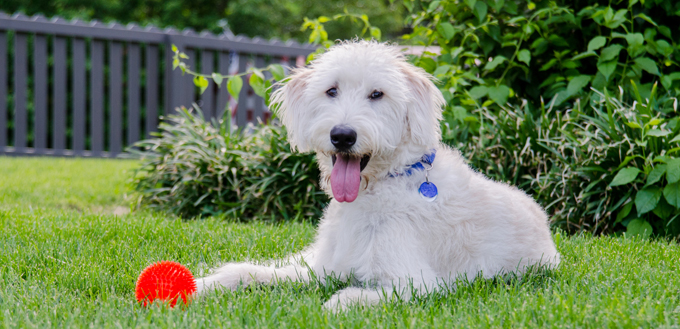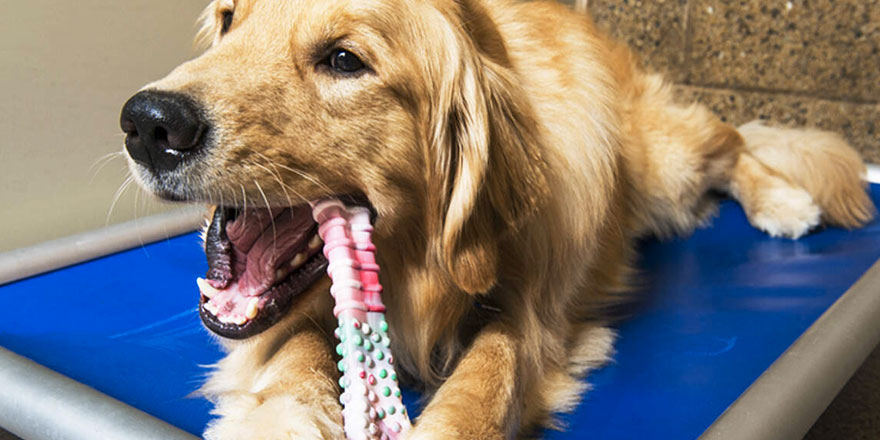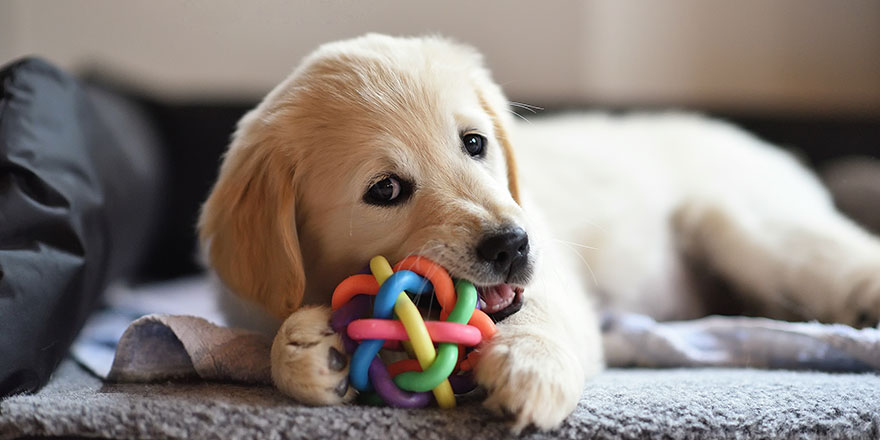Nylabone is one of the most trusted names when it comes to dog chews and canine chew toys. It is a total surprise to hear many pet owners rushing their dogs, especially puppies, to emergency veterinary facilities because their pets have ingested a piece of a non-edible Nylabone chew toy. Indeed, the experience can be downright stressful that you’d be asking yourself how a trusted brand like Nylabone could create a product that can bring your beloved pet to the emergency room. This raises the question of whether Nylabone chew toys are safe for dogs.
A Primer on Dog Chews
Before we take a deeper look into the safety issue raised against the products of Nylabone, it is crucial to understand the reason behind the creation of such doggie toys first. Is it really necessary to give our dogs something to chew on?
The short answer is ‘yes’, they need something to chew on because it is already ingrained in their genes. Even though we have already learned to domesticate and tame them, they are predators. A part of their being animals of the wild still resides within that cute personality we all love about our pooches. One of these innate behaviors is to chew, especially on puppies.

There are many reasons why dogs chew. Here are some of them.
As a means of exploring their world
Puppies are exploring their world. Unlike human babies, puppies cannot grab onto things, so they can appreciate their texture and other characteristics. They can only do that by using their mouths to grab and hold onto objects. They try to chew on things to see what happens next. For instance, if they chew on your carpet and you withhold their playtime with you, they learn that doing so will deprive them of your playfulness. Chewing is one of the methods by which young dogs learn about things and certain rules.
As a way to alleviate teething pain or discomfort
Every organism that has teeth will go through a teething process. Teeth are already developed underneath the gums. They are only waiting for the right time and stimulus to break through the gums. In many cases, the permanent teeth are not far behind, pushing the temporary teeth out of the way. This causes pain or discomfort. Chewing on a hard object produces a different kind of sensation that somehow overrides the pain signals sent to the brain by the erupting teeth. In a way, this soothes the gums and makes for a more manageable teething process.
As a method of cleaning the teeth
Dogs don’t know how to use a toothbrush and toothpaste to clean their teeth. However, they know that if they rub their teeth against something that is hard and has ridges, they can effectively remove any food particles that may have gotten stuck between their teeth.
As a form of exercise to strengthen the jaws
Experts say that dogs also chew because they have an inherent need to strengthen their jaws, which all predatory animals must learn early. With stronger jaws, they can latch onto their prey with relative ease and without letting the prey free. That is why if you are playing tug with your pet, you’ll notice that it will never really let go. This is because, in your dog’s mind, what is in between its teeth is actually prey.
As a means of combating boredom and mild anxiety
Just as some of us have oral fixations that manifest every time we feel stressed out, dogs, too, typically have oral fixations to alleviate mild anxiety or even fight boredom. If you haven’t noticed, some of us tend to eat even though it’s not time for a snack or a meal if we feel stressed. Some would talk endlessly for hours while others will be drinking or another behavior closely related to the mouth. The same is true with dogs. They can bark, make other vocalizations, and chew if they feel anxious or bored. This behavior is also observed in frustrated dogs.
Without canine chew toys, your pooch will not be able to accomplish many of these things. True, they can chew other things. But would you rather have your dog chew on your carpet, bedding, curtains, clothing, upholstery, and furniture and destroy every other piece of belonging you have in your home? Obviously, not. So, whether we like it or not, a chew toy is important to keep our dogs healthy and mentally sane.
The Issue about Nylabones
One of the main issues raised against Nylabone non-edible dog chew toys is that they break easily, and these broken pieces are inadvertently ingested by dogs. Generally, if the piece that broke off is relatively small and the dog chewing on it is a large breed, there is no immediate danger of choking. However, since these products are essentially made of nylon, rubber, or even plastic, there is a risk of irritating the lumen of the gastrointestinal tract.
The concern is more on small breeds of dogs and puppies with smaller digestive tracts. If the piece that broke off is sufficiently large and is ingested by your small or young pooch, there is a chance that this piece might get lodged into one of the smaller diameter sections of the dog’s gut. This can lead to intestinal obstruction. Depending on the size and severity of the lodgment of the broken-off piece, surgery may be required to remove it.
For this reason, many pet owners who have had the experience of their dogs having intestinal obstruction secondary to ingestion of a Nylabone dog chew toy consider these products unsafe.
What Nylabone Has to Say
Before you pass judgment on this case, let us look at what Nylabone expressed in its disclaimer for its non-edible dog chew toys. We will lift some of the statements of that disclaimer for us to analyze closely. If you have a package of a Nylabone product, you can also read the disclaimer.
- Non-edible dog chew products are not intended for consumption.
- If a large piece of the dog chew has broken off, you need to take the dog chew away and seek veterinary advice.
- Nylabone should never be boiled or placed in a washing machine, microwave oven, convection oven, or dishwasher.
- Always check to see if the dog’s chew is whole and intact.
- No dog chew is completely or indestructible.
- If the chew toy has become too small to be chewed on safely, it should be replaced immediately.
We would like to point out a few things in this disclaimer.
Vigilance
One of the very first things that are very obvious in the Nylabone disclaimer is for pet owners to be vigilant. What Nylabone is saying is that it is the responsibility of the dog owner to make sure that the product is safe to be chewed on by your dog. If there are signs of deteriorating parts, perhaps scratch marks or cuts that are beginning to become deep, these should no longer be given to dogs. It specifically says that the Nylabone should be whole and intact. This simply means that we need to inspect it every time we give the chew toy to our dog so that we can be very sure that it will not break easily. Should you still give it to your dog if any structural weakness is observed? Being vigilant simply means being observant and very attentive to even the tiniest details of what you’re giving to your dog.
Supervision
What is also implied in the disclaimer is the concept of active supervision. Veterinary and animal behavior experts will tell you to always supervise your dog while it is playing with its chew toy. Under no circumstances are you supposed to leave your dog alone, feasting on its non-edible chew toy. As such, at the first sign that a piece broke off, you can already do something about it rather than wait for your dog to start showing signs of intestinal obstruction.
Proper care
The disclaimer also points to what you should never do to a Nylabone non-edible chew. In effect, what the company is saying is that you should also make an effort to care for these products as subjecting them to unnecessary heat and harsh chemicals can hasten their degradation, exposing your dog to safety issues.
Are Nylabones Safe for Your Dog?

It should be safe if you strictly adhere to the guidelines for using a dog chew toy, including actively supervising your pup every time it has a chew in its mouth. If there is one thing that we should all remember as pet parents, our pets have no idea whether the things we give them are safe or not. Since we are the ones who are purchasing these products for our dogs to use, then it is our responsibility to make sure that they are kept safe using such products. If we cannot guarantee their safety, then there is no point in buying such products, is there?
Again, we would like to reiterate three things whenever you give your pooch a chew toy.
Always inspect the chew toy before, during, and after being used by your dog.
It is crucial to assess the chew toy straight from the package before giving it to your dog. This is to make sure there are no small parts that will easily break off. You will also need to paint a picture of the chew toy in your mind so that the next time you assess it after your pup is done chewing on it for some time, you can make accurate evaluations of whether it has changed dramatically or not. If parts or sections are now showing some cut or tear, this should raise a red flag. You can either replace it immediately or continue giving it to your dog but with a much more guarded observation.
Make sure never to leave your dog while it is chewing on a toy.
We always tell our friends never to leave their dogs unsupervised if they are playing with something, be it a non-edible dog chew toy or even an edible one. The reason is simple: would you leave your baby alone while he or she is feeding or playing? While our dogs are not babies, they have a lot in common with our little ones, but for the most part, they depend on us.
Learn how to properly care for such dog chew toys.
This starts with a clear understanding of what the chew toy is made of. If it is nylon, you can bet it can resist chewing much better than rubber, although certain rubber compounds are tough. The same is true with plastic. You can use this knowledge to tailor-fit your assessment activities. In general, however, you are not supposed to expose these to heat as it can degrade the integrity of the chew toy. Similarly, using harsh chemicals to clean these is not a good idea either. Nylabone and other manufacturers of chew toys have a complete list of how you can take better care of their respective products. Heed these well, and you’ll go a long way.
Some Things You Need to Consider when Choosing a Dog Chew

We’ve practically covered what you must do to ensure your dog remains safe while chewing on a toy like Nylabone. However, a much better solution is to be able to pick a doggie chew toy that is perfect or right for your canine friend. Here are some things for your consideration.
Size
The size of the Nylabone or any other dog chew should be just right for your pooch’s mouth. Your dog should be able to open its mouth, hold onto the toy, and still be able to move its jaws in an up-and-down motion. If there is limited vertical movement, you risk injury to your pooch’s jaws. If the Nylabone is too small that your canine friend can easily swallow it, you also risk having your pooch develop intestinal obstruction or choke it.
Dog’s chew personality
There are three types of chewers among dogs. The first is the gulpers or inhalers. These dogs will chew on a toy, bite a large chunk of it, and, next thing you know, there is no more trace of that broken-off piece. The second type is the destroyer. These do not tend to swallow or ingest the broken-off pieces. Instead, they find pure pleasure in ripping or shredding things apart. Unfortunately, they are sometimes mistaken for gulpers and vice versa. The third types of chewer are the nibbler. They are lovable. They adore their chews that they will spend countless hours simply nibbling on these toys. They savor every lick and small bite they make on the toy.
You can choose the more appropriate chew toy based on these types of chew personalities among dogs. For instance, gulpers benefit from tennis balls, rope chew toys, and even firm rubber chew toys. Destroyers will want rawhides, bully sticks, and edible chews. Nibblers will love almost anything you give to them.
Dog’s chew strength
Just because you have a small dog breed doesn’t automatically mean it is not a tenacious chewer. The thing is that even dogs of the same breed can have different chew strengths. Technically, this is closely related to your dog’s chew personality. For instance, destroyers and gulpers are almost definitely power chewers, while nibblers are more soft chewers.
What to Do If Your Dog Ingested a Part of Nylabone
Make no mistake, if a large piece of Nylabone non-edible chew toy breaks apart and is ingested by your dog, it will cause problems. At the very least, your dog will be experiencing some form of stomach discomfort until it can pass the broken piece through its stool. If the part is large enough, it might obstruct the small intestines.
Unfortunately, there is no way of telling whether the broken-off piece will pass through the rectum or get lodged in the gut. As such, like what Nylabone expressed in its disclaimer if you think in any way that your puppy ate a part of Nylabone, you should seek veterinary consultation immediately. He will order an x-ray to visualize where the Nylabone is and how big it is relative to the gut. If it is large and cannot possibly pass through the rectum, you have to get ready for emergency surgery.
Nylabone and dog chew generally are safe, provided you adhere to certain safety guidelines. Vigilance, supervision, and correct chew toy care must protect our dogs from these products.
Sources:
- Dog toys: How To Pick The Best And Safest, The Humane Society of the United States
- Danny Prater, Are Dog Bone Treats Dangerous? Here’s What You Should Know, PETA
- Nylabone Allergies in Dogs, Wag!






